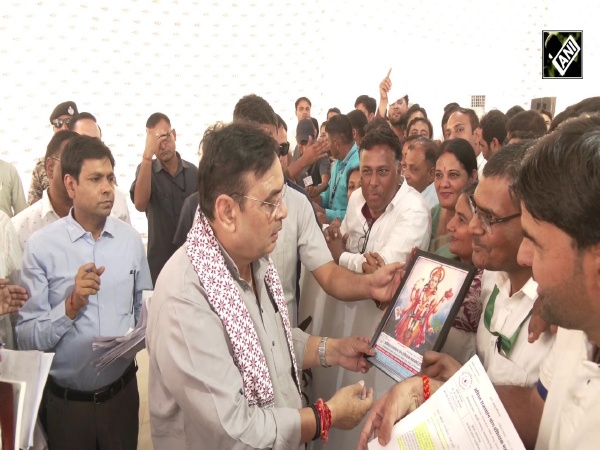Staff able to draw boundaries between work and home, institutionalisation humanised workspace: CJI
Sep 15, 2023

New Delhi [India], September 15 : Institutionalisation in addition to enhancing transparency also humanised workspace, said Chief Justice of India DY Chandrachud in a lecture adding it enabled the staff to draw boundaries between work and home.
“One of the important effects of institutionalising courts is that it enhances transparency and accountability. While these are very important effects of institutionalisation, we should also not forget the human side of the story,” said the Chief Justice in his Ram Jethmalani Memorial lecture on his birth centenary year in the national capital.
Further, he said, “I have in the course of the ten months as the chief justice realised that institutionalisation in addition to enhancing transparency also humanises the workspace. The staff are able to draw boundaries between work and home and increase the work efficiency. It has also positively changed things for those on the other side that is the bar.”
The chief justice said that when he assumed office, prioritising the mental health of lawyers and registry officials by not pushing them to overwork themselves was one of his top concerns.
“The Covid pandemic had just started receding when I took over as Chief Justice of India, I was aware of the huge responsibility which I would be shouldering. Most of us had lost somebody dear. The pandemic had not only brought the world to a standstill but also left emotional scars from which we are yet to recover. While I knew that I had to prioritise speedy disposals, I also knew that I had to prioritise the mental health of lawyers and registry officials by not pushing them to overwork themselves,” CJI Chandrachud said.
Talking about the new reforms implemented in the Supreme Court, the chief justice said that now filing of cases, and submission of urgent listings among other processes that needed paperwork can be done through the top court’s online portal.
“We have implemented the filing of cases in the electronic form, removal of defects, submission of urgent listings and appearance slips, all through online portals in the Supreme Court. It is way more easy now to file pleadings than to live in the anxiety of standing in line waiting for a person to mark defects in the file and returning it to be filed afresh,” Chandrachud said.
He added, “Citizens can now find out the status of their cases instead of having to rely on their advocates who because of their busy schedules may not always relay the update. Of course, this is the change and changes don't come easy but it is change worth making for enhancement of the justice delivery system.”
He also highlighted that by enhancement in the top court he is referring to the reducing barriers to accessing court as well improving the gender ratio of lawyers further adding that only through a holistic approach quality of justice delivery could be enhanced in every sense.
“At this point, it is necessary to emphasize that when I speak about enhancement I do not limit the reference to quality judgement. My focus is also on reducing barriers to accessing the courts, easing the process of filing and arguing before the court. My focus is on improving the gender ratio of lawyers. My focus is on ensuring that lawyers and litigants have facilities to comfortably rest while at court. It is only with such a holistic approach that the quality of justice delivery could be enhanced in every sense of the word,” the chief justice said.
He also said that a move to replace the SC’s old building complex is also underway which equips the needs of everyone.
“Our building was constructed in 1950 and we have moved the government with the blueprint of a new building to replace one of our older building which was constructed in late 1980s or 90s and to have a modern Supreme Court building in the same complex with 27 courtrooms, bar association spaces for the women lawyers, Supreme Court bar associations for the advocates on record and above all for our litigants,” CJI Chandrachud said in his lecture.
CJI also said that one of the primary requirements for institutionalising court system is to identify the issues that hampers its efficiency and curating remedies.
The chief justice further emphasized, “One of the primary requirements for institutionalising the court system is to identify the issues that hamper our efficiency and curating remedies to address such issues and able team of judges, lawyers and researchers working at the centre for research and planning are assisting the courts with this work. Their work is invaluable particularly because of the lack of research and data on the functioning of courts in India.”
CJI further mentioned that the Centre for Research and Planning is now in the process of creating a system that managing and reducing the case pendency through a project called SCJUDICARE which stands for Judicial Disposal through Case management and Resource Efficiency.
“The project aims to increase efficiency through case classification, grouping and tagging. Phase 1 of the project is underway where we have collected data on pending dockets to frame guidelines,” he added.
Further, he said that a roadmap for auditing criminal matters has also been prepared.
“Our aim is to integrate granular data with integrated case management systems, identify infructuous matters and devise strategic priorities at an institutional level,” he said.
Chandrachud asserted that the courtrooms in the top court are becoming tech-friendly.
“We are also now moving to a paperless mode of pleadings and communication. Courtrooms of the Supreme Court are becoming tech-friendly. In courtrooms 1-3 of the Supreme Court, the law-books that once marked the perimeter of the room are replaced with e-libraries. Digital display systems have been installed for judges and advocates,” he said.
The chief justice said that in the Constitutional bench hearing the challenge to the abrogation of Article 370 that concluded recently saw a record of 47,835 pages of paper-book.
“Case documents, case law, compilations and written submissions of the petitioners and respondents. All of them were scanned and digitised to allow a paperless bench and a largely paperless bar,” he added.
“I like to practice what I preach. In my office, all communications for approval with the registry, even internal notes taken through the paperless mode, through e-office,” said the chief justice, adding, “When I took over as Chief Justice, I realised that the sheer frequency and volume of approval that is required for every decision taken by the court staff and the registry including the flowers that are put in the foyer of the Supreme Court. Each time the staff would come to me with a stack of papers to peruse only for a signature. I took a call and asked the staff in the registry to send over e-documents which are now e-signed by me.”
Remembering Ram Jethmalani, CJI Chandrachud said that by witnessing these reforms in the top court, he must be smiling with pride “sitting between the twinkling stars”.

















